Christianity, with approximately 28 Million Indian followers constitute 2.3 percent of India’s population. It is traditionally believed that Christianity was introduced to India by Thomas the Apostle, who supposedly landed in Muziris, Kerala in AD 52 and traveled along the coast to Goa spreading the word of Christ.
Roman Catholicism was first introduced to India by Portuguese, Italian and Irish Jesuits in the 16th century to preach the gospel of Jesus Christ among Indians. Most Christian schools, hospitals, primary care centers originated through the Roman Catholic missions brought by the trade of these countries. Evangelical Protestantism was later spread to India by the efforts of British, American, German, Scottish missionaries. These Protestant missions were also responsible for introducing English education in India for the first time and were also accountable in the first early translations of the Holy Bible in various Indian languages (including Tamil, Malayalam, Telugu, Hindi, Urdu and others).
Even though Christians are a significant minority, they form a major religious group in three states of India – Meghalaya, Mizoram, and Nagaland with plural majority in Manipur and Arunachal Pradesh and other states with significant Christian population include Tamil Nadu and Kerala. Christianity is widespread across India and is present in all states with major populations in South India. With over 28 Million adherents, Christianity is the fourth largest religion in India, after Hinduism, Sikhism and Islam.
According to Indian Christian traditions, the Apostle Thomas arrived in Tamilakam presently in the Indian state of Kerala Kodungallur (also Muziris), Kerala, established the Seven Churches and evangelized in present-day Kerala and Tamil Nadu.
India’s oldest church, claimed to be the world’s oldest existing church structure and built by Thomas the Apostle in 57 AD, called Thiruvithamcode Arappally or Thomaiyar Kovil as named by the then Chera king Udayancheral, is located at Thiruvithancode in Kanyakumari District of Tamil Nadu, India.
The Apostle Thomas arrived in Kodungallur and established the Eight Churches and evangelized in present-day Kerala and Tamil Nadu. As with early Christianity in the Roman Empire, it is assumed that the initial converts were largely Jewish proselytes among the Cochin Jews who are believed to have arrived in India around 562 BC, after the destruction of the First Temple. Many of these Jews presumably spoke Aramaic like St. Thomas, also a Jew by birth, who is credited by tradition with evangelizing India. Many of these churches came up near Jewish settlements where Jewish community had been living there for some time engaged in trades. These were Ezharappallikal at Maliankara (Kodungallur), Kollam, Niranam, Nilackal (Chayal), Kokkamangalam, Kottakkayal (Paravoor or Kottakkavu), Palayoor (Chattukulangara) and Thiruvithamkode (Kanyakumari). Among them the one at Maliankara is considered as first church. The church near Kanyakumari was a small one, Arappally means Half Church.St. Thomas lived in India for 17 years: 4 years in Sindh (now in Pakistan), about 6 years in Malabar Coast and 7 years at Mylapore in Tamil Nadu where he was martyred. His Mortal remains are in St.Thome Church in Mylapore, Chennai. The Indian Postal Service of the Government of India brought out two commemorative stamps, in 1964 and 1973, in honor of the historic arrival of St. Thomas in India in 52 AD.
1. The Marthoma Pontifical Shrine – Kodungallur:
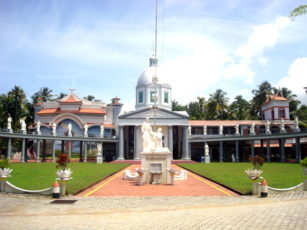
The Church is considered to be the first one to be built by St Thomas after his arrival to Kodungallur in 52 AD. The church is a major pilgrimage centre which is located on the banks of the Periyar river. The church houses the right arm bone of St Thomas which was brought from Ortona in Italy. The church is built in fusion of Indo-Persian styles of architecture on land measuring 3500 sq ft. The shrine also plays a 30 min documentary covering the life and times of the Apostle.
2. St Thomas Syro – Malabar Catholic Church – Palayoor:
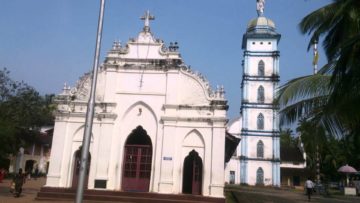
This church is located at Palayur (also spelt Palayoor), in Thrissur district in Kerala was also a small church originally, still retaining the oldest structure. The credit goes to Rev. Fr. Fenichi who made vast improvements to the church during the 17th century without compromising on the main sanctity and heritage value of the place.
St. Thomas traveled all the way from from Muziris (Kottakkavu or Kodungallur) and landed at Palayur by boat through the backwaters. Palayur, also known as Bottukulam because of the historic location of boat jatty, was then a stronghold of the Brahmins of Kerala Nambudri and also of Jews. He visited the Jewish merchants at Palayur to preach the Christian gospel. The place is preserved as a monument to St. Thomas.
3. The Nilackal St. Thomas Church – Kokkamangalam
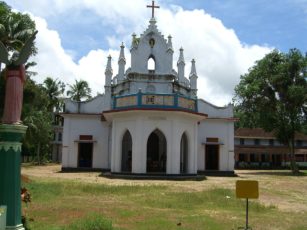
Occupying a midway position among the seven churches founded by St. Thomas, the Kokkamangalam Church holds an important place. Here a portrait of St. Thomas is held in great veneration and it was brought from the Carmelite Monastery Mannanam in 1897 by “Albhutha Mathai”, pursuant to a revelation. This portrait is carefully mounted in a decorated waft of great artistic value.
4. Kottakkavu Church – North Paravur:
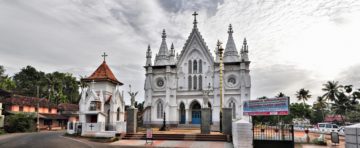
Kottakkavu Church established by St. Thomas has two churches more. Mar Sabor and Mar Proth, who came from Persia to Malankara in the 9th century built and managed over a number of churches in Malankara, following the tradition of Saint Thomas Christians. The second church of Kottakkavu was rebuilt in 9th century. After their demise, they were remembered as saints and their name was given to this church. The existing old church – the third church, was built in 1308. The second church of Kottakkavu was rebuilt in 1575. Kottakkavu Sliva, a Persian Cross engraved on granite stone by Mar Sabor and Mar Proth, is preserved in the chapel in front of the church.
5. St. Mary’s Orthodox Syrian Church – Niranam:
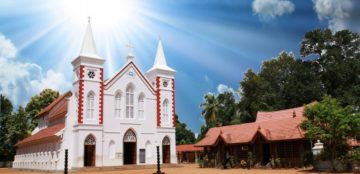
Niranam church, founded by St. Thomas in AD 54 had been rebuilt several times since then for various reasons. The stones in the church shows the reconstruction in 1259. It is a Malankara Orthodox Church. The present building, supposedly the fourth, was built in 1912 and renovation was done in the year 2000. There are five altars at Niranam church.
6. St Thomas Church – Nilakkal:
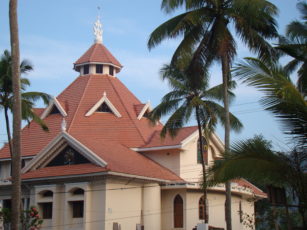
The Nilackal St. Thomas Church was established by him in Nilackal a wooded area, almost 52 kilometers east to Ranni and near Sabarimala. There was a mountain route of trade between Kerala and Tamil Nadu. Saint Thomas, along with his disciple baptized 1100 people. Today St. Thomas Church, still retains the old value and Ecumenical center trust and the cross established by Saint Thomas, the apostle. It is 3 km from Angamoozhy in Pathanamthitta district of Kerala and some distance from the river pamba on the way to Sabarimala. In 1902, during the British period, the remains of an ancient Christian church and cemetery were accidentally discovered in the forest area of the south of the Western Ghats, on the road to the ancient Hindu shrine of Sabarimala in the practically inaccessible mountain terrain. The British took an interest in the discovery it was suspected that the church was built in the first century. The presence of a Hindu temple near the Christian site and the controversial issues that came up later delayed the building of a church. However, both communities, with mutual trust, solved the ‘Church construction issue’ amicably, fully supported by the government. A new church has been built under the joint auspices of all the Christian denominations at the site mutually agreed upon by all parties concerned, a little distance away from the earlier site. Being the first church built far away from the coast, efforts were made to preserve it as a symbol of the heritage from St. Thomas.
7. Kollam Church:
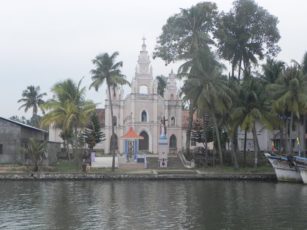
In ancient times, Kollam was a major harbor and trade centre, due to which St Thomas established a church near the port. The church was destroyed during the temporary transgression of the Arabian Sea; however, in the year 1986 Pope John Paul II laid the foundation stone for a church to be constructed at the spot which is the present Port Church or Our Lady of Purification Church.
8. St Mary’s Church – Thiruvithamcode:
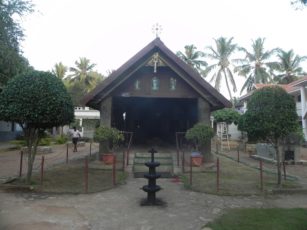
Thiruvithamcode Arappally or Thomayar Kovil, located in Thiruvithamcode, Tamil Nadu, India was built by St. Thomas, now known as the Apostle of India, in 63 AD. The Christian communities in Kerala believe that the historic Thiruvithamcode Arappally, also called Amalagiri church was named by the Chera King Uthiyan Cheralathan. It is one of the world’s oldest churches that still has daily prayers and it has three main parts built in the 17th century and a 20th-century entrance hall. India’s oldest church is yet to undergo reconstruction. Thiruvithamcode is a small panchayat town located in the Kanyakumari district, Tamil Nadu. It is about 20 km from Nagercoil town, and 2 km from Thuckalay.
